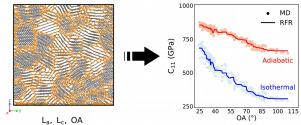当前位置:
X-MOL 学术
›
Acta Mater.
›
论文详情
Our official English website, www.x-mol.net, welcomes your feedback! (Note: you will need to create a separate account there.)
Elasticity of dense anisotropic carbons: A machine learning model of the structure–property relationship informed by large scale molecular dynamics data
Acta Materialia ( IF 9.4 ) Pub Date : 2024-03-25 , DOI: 10.1016/j.actamat.2024.119851 Franck Polewczyk , Jean-Marc Leyssale , Philippe Aurel , Nicolas Pineau , Christophe Denoual , Gerard L. Vignoles , Paul Lafourcade
Acta Materialia ( IF 9.4 ) Pub Date : 2024-03-25 , DOI: 10.1016/j.actamat.2024.119851 Franck Polewczyk , Jean-Marc Leyssale , Philippe Aurel , Nicolas Pineau , Christophe Denoual , Gerard L. Vignoles , Paul Lafourcade

|
Dense anisotropic carbons are praised materials for thermostructural applications, yet, so far, a detailed structure–property relationship for these materials is still lacking, especially for the pyrocarbon (pyC) matrices in carbon/carbon composites. Here we compute the full elastic tensors of 210 recently introduced nanoscale models of anisotropic carbons (Polewczyk et al., 2023), covering domain sizes (L and L) and orientation angles (OA, as a measure of nanotexture) relevant to most as-prepared and moderately heat-treated pyC matrices: L [1.5:8 nm]; L [2:5.5 nm]; and OA [25:110°]. Isothermal and adiabatic elastic tensors, corresponding to the slow quasi-static and ultra-fast loading regimes, respectively, are considered. Analyzing the database of computed elastic constants with a random forest regressor supervised learning algorithm we show that all elastic constants can be predicted accurately using L, L and OA as descriptors. Among the latter, OA is the one showing, by far, the strongest correlation with the elastic tensors. For such dense, non porous carbons, 3 of the 6 isothermal and 5 of the 6 adiabatic constants can even be accurately predicted using OA as the unique material descriptor. Calculation of the universal anisotropy index shows that isothermal tensors show more anisotropy than adiabatic ones, indicating that stress relaxation favors elastic anisotropy. Eventually, the Young’s moduli and Poisson coefficients of six models of actual pyCs are presented and their longitudinal moduli compared to tensile measurements, showing relatively poor agreement. These results suggest that accounting for texture at a larger scale is required to capture pyC matrices elasticity. The developed supervised learning model is available for online use at .
中文翻译:

致密各向异性碳的弹性:大规模分子动力学数据提供的结构-性能关系的机器学习模型
致密各向异性碳是热结构应用中备受赞誉的材料,但到目前为止,仍然缺乏这些材料的详细结构-性能关系,特别是对于碳/碳复合材料中的热解碳(pyC)基体。在这里,我们计算了 210 个最近引入的各向异性碳纳米级模型的完整弹性张量(Polewczyk 等人,2023),涵盖与大多数相关的域尺寸(L 和 L)和取向角(OA,作为纳米纹理的度量)。制备并适度热处理的 pyC 基质:L [1.5:8 nm]; L[2:5.5纳米];和 OA [25:110°]。考虑分别对应于慢速准静态和超快加载状态的等温和绝热弹性张量。通过使用随机森林回归监督学习算法分析计算弹性常数的数据库,我们表明可以使用 L、L 和 OA 作为描述符来准确预测所有弹性常数。在后者中,OA 是迄今为止与弹性张量相关性最强的一个。对于这种致密、无孔的碳,甚至可以使用 OA 作为独特的材料描述符来准确预测 6 个等温常数中的 3 个和 6 个绝热常数中的 5 个。通用各向异性指数的计算表明,等温张量比绝热张量表现出更多的各向异性,表明应力松弛有利于弹性各向异性。最终,给出了实际 pyC 的六个模型的杨氏模量和泊松系数,并将它们的纵向模量与拉伸测量结果进行了比较,显示出相对较差的一致性。这些结果表明,需要在更大范围内考虑纹理才能捕获 pyC 矩阵弹性。开发的监督学习模型可在 在线使用。
更新日期:2024-03-25
中文翻译:

致密各向异性碳的弹性:大规模分子动力学数据提供的结构-性能关系的机器学习模型
致密各向异性碳是热结构应用中备受赞誉的材料,但到目前为止,仍然缺乏这些材料的详细结构-性能关系,特别是对于碳/碳复合材料中的热解碳(pyC)基体。在这里,我们计算了 210 个最近引入的各向异性碳纳米级模型的完整弹性张量(Polewczyk 等人,2023),涵盖与大多数相关的域尺寸(L 和 L)和取向角(OA,作为纳米纹理的度量)。制备并适度热处理的 pyC 基质:L [1.5:8 nm]; L[2:5.5纳米];和 OA [25:110°]。考虑分别对应于慢速准静态和超快加载状态的等温和绝热弹性张量。通过使用随机森林回归监督学习算法分析计算弹性常数的数据库,我们表明可以使用 L、L 和 OA 作为描述符来准确预测所有弹性常数。在后者中,OA 是迄今为止与弹性张量相关性最强的一个。对于这种致密、无孔的碳,甚至可以使用 OA 作为独特的材料描述符来准确预测 6 个等温常数中的 3 个和 6 个绝热常数中的 5 个。通用各向异性指数的计算表明,等温张量比绝热张量表现出更多的各向异性,表明应力松弛有利于弹性各向异性。最终,给出了实际 pyC 的六个模型的杨氏模量和泊松系数,并将它们的纵向模量与拉伸测量结果进行了比较,显示出相对较差的一致性。这些结果表明,需要在更大范围内考虑纹理才能捕获 pyC 矩阵弹性。开发的监督学习模型可在 在线使用。



























 京公网安备 11010802027423号
京公网安备 11010802027423号